Hartford and New Haven’s Proud and Distinguished History of Supporting Jazz
Jazz In Connecticut — The Early Years
By OWEN McNALLY
Special to The Courant
(This article is part of The Hartford Courant’s 250 years in publication celebration: www.courant.com/250)
Reprinted with permission.
With fabled clubs in the North End rocking with the sound of jazz, classic big bands and big-name instrumentalists and singers routinely blowing-off the roof at Foot Guard Hall on High Street, or shaking the foundations of the State Theater on Village Street, Hartford’s vibrant, pre and post-World War II scene was the city’s first “Golden Age of Jazz.”
Jazz was not only flourishing artistically, but was very much the music of the day for young people through the 1930s, all of the ‘40s and well into the 1950s. At its zenith in Hartford, jazz was everywhere and for everyone. Typically among the jazz fold were the young adults and slightly older, more urbane patrons who in the ‘50s regularly dug the suave, swinging sounds of the elegant jazz pianist Teddy Wilson at the legendary Heublein Hotel lounge in downtown Hartford.
One of the city’s crown jewel venues of the 20th century, the lounge in the venerable hotel was a softly lit, elegant jazz spa right out of a vintage, black-and-white Hollywood flick. It was a sophisticated, posh place where, if you wore a jacket and a tie and acted like an adult, you could get served a Scotch on-the-rocks or an extra-dry martini even if you were a couple years under 21, then the legal age for getting a drink in Connecticut.
A younger, less inhibited set of jazz lovers in that era danced in the aisles at Hartford’s hallowed cultural center, The Bushnell Memorial, at Norman Granz’s fabled Jazz at the Philharmonic (JATP) concerts, upsetting the management’s sense of propriety a bit.
Moved by that JATP-generated passion, more unruly patrons in the mezzanine shouted out, “Go, man, go!’ to the steamy, honking, erotically-charged tenor saxophone riffs of the swaggering Illinois Jacquet, the master machismo music-maker. Sedentary swingers, in sedate contrast, merely tapped their feet to a swinging, surreal scat solo by Ella Fitzgerald. Or with Zen-like hipness, the coolest of cool JATP fans, experiencing their very own introspective, natural high, would quietly savor a mesmerizing, melodically inventive, gossamer solo by the divinely inspired tenor saxophonist Lester Young, JATP’s jazz Buddha whose spiritual solos were as holy as a Gregorian chant.
For all its power and glory from the 1930s through the 1950s, jazz didn’t exactly start off like a ball of fire in Hartford. Its shock of the new qualities were just too shocking and too new for skeptical critics and elitist listeners who, nearly as far back as 100 years ago, found it noisy, noisome, uncultivated and uncouth.
In the early 1920s jazz’s reception and public perception varied in Hartford from irate complaints from Colt Park neighborhood residents about “dance music jazzing from the park’s pavilion” to a somewhat lukewarm notice in The Courant praising a Navy jazz band “for enthralling crowds at The Capitol Theater” where the jazzy sailors shared the vaudeville bill with trick bicyclists, a singing/dancing child act, acrobats, contortionists and a singing monologist—hardly promising signs of things to come for America’s new music in Hartford.
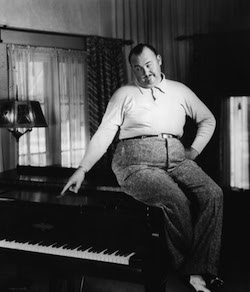
Paul Whiteman
Celebrated orchestra leader Paul Whiteman, somewhat grandiloquently billed as “The King of Jazz,” fared far less well than The Capitol’s novelty sailor band in a Courant review of the portly maestro’s performance in 1924 at Foot Guard Hall. Looking down his nose (or perhaps holding it) a rather snooty, culturally patronizing Courant reviewer declared that the rotund bandleader’s orotund attempts at gussying up jazz failed miserably to measure up to “good music as (it) has been generally understood by cultured people these many years.”
“It gets terribly monotonous in its rhythms to those whose ears have been attuned to that which they fondly and firmly believe is infinitely and eternally better in music,” the dyspeptic Courant scribe lamented.
A positive economic side effect of jazz—at least for the piano tuning business—was cited in a sarcastic Courant news item in the 1920s reporting, with a derisive tone, that the outbreak of the excessively heavy pounding by jazz pianists was putting pianos across the nation out of tune “in about half the time it took formerly.”
Adding insult to mockery, The Courant in 1926 polled its readership on whether the performance of jazz should be permitted in public on Sundays. With 1,143 readers voting to keep Sunday safe from the corrupting temptations of jazz, the convention-flouting music lost by a landslide as only 349 readers lined up in favor of allowing Satan’s latest sinful, musical concoction to profane the Sabbath.
But as the Jazz Age evolved and modern popular culture—everything from silent films, the rising radio-craze, flapper fashions, hip flasks and hip music—became an irresistibly powerful social force, praise began to crescendo for jazz in The Courant as the syncopated sounds became increasingly popular in Hartford, converting perhaps even some of the paper’s once avid, anti-jazz readers.
By the 1930s, Duke Ellington and his singer Ivy Anderson received a rave review in The Courant for being “especially musically intelligent.” Even as the stock market plunged, jazz’s stock was rising in Hartford. Count Basie and his orchestra, for example, were royally hailed for playing at an upscale ball held at, of all places, the prestigious Hartford Club, with absolutely no caveat emptors issued by The Courant writer about the primal crudities of jazz offending the cultivated listener’s superior musical sensibilities.
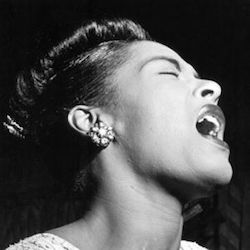
Billie Holiday
A performance at the State Theater featuring the swinging Jimmy Lunceford Orchestra and diva Billie Holiday was even awarded the highest accolade by a Courant entertainment writer for what she described as its “pop and oomph,” which seems to have superseded the paper’s earlier critical category for jazz as strictly sturm und drang.
By the late 1930s and ‘40s, jazz had shifted into high gear in Hartford. Its influence was mushrooming everywhere. You could catch it at such then wildly popular but now long forgotten venues as the Paddock in East Hartford, where such national notables as pianist Art Hodes and trumpeter Will Bill Davison wailed. Or you could test your luck at the city’s once flourishing Clover Leaf where, at least according to local legend, the storied pianist/composer Jelly Roll Morton was hired to help bibulously ecstatic Hartfordites celebrate the glorious repeal of Prohibition in 1933.
During its first Golden Age in Hartford, jazz was hot and accessible, although its conservative detractors still thought it not quite proper; perhaps even a sinful primrose path leading directly to drunkenness, drugs and debauchery.
Long before college radio, you could hear jazz on the air on WTIC on a pioneering show called “Gems of American Jazz.” Hosted by Connecticut’s “foremost jazz musicologist” George Malcolm-Smith, it debuted in 1942, establishing a hip, or maybe back then, a hep radio tradition carried on in more recent times by invaluable college FM radio stations beaming their jazz message across the state.
One of the city’s most flamboyant and devout early supporters of jazz, Malcolm-Smith (1901-1984) was a noted comic novelist, a founder and onetime president of the Hartford Jazz Society (HJS) and a sometime jazz critic for The Courant.
Dashing, dapper and madly in love with jazz in all its forms, he was a celebrated figure about town. A humorous man of intellectual substance, he accentuated his elegant manner by smoking his favorite brand with a cigarette holder held and bandied about in the grand gestural manner of FDR. Perhaps because he had a deep sense of history and of the lasting value of the music, Malcolm-Smith’s voluminous, chatty but information-packed “Swinger” newsletters for the HJS are an invaluable chronicle of the Society’s formative years, a rare archive of written documents waiting to be mined by a jazz historian.
A raconteur and bon vivant, Malcolm-Smith was a genuine 20th century Hartford wit. His banter and cultural erudition would have made him right at home exchanging quips and barbs with such heavyweight humorists as Bob Benchley and Dorothy Parker at the Algonquin Hotel’s famously funny roundtable gatherings.
In that long ago happily abundant, first Golden Age of Jazz, you could hear jazz live just about anywhere in Hartford. It could be Art Tatum or Stan Kenton on stage at The Bushnell. Or it could be the young Dave Mackay, the brilliant, blind pianist, Lennie Tristano protégé and Trinity College undergrad grooving high before an excited, packed house at one of the two, swinging Elks Clubs in the North End.
You could duck into a downtown bar or restaurant, grab a drink and, if you were lucky, catch a smokin’ set by one of the gifted Connecticut jazz heroes of the day like alto saxophonist Jack O’Connor, a hard-playing, hard-living player of prodigious talent. His hometown fans claimed that at his passionate, fluent best, O’Connor was at least the equal of alto greats Phil Woods or Gene Quill—maybe even sharper than Quill. Taking a few steps down Asylum Street and into an inviting restaurant, you might walk-in on the awesome musings of the marvelous, Hartford piano virtuoso Ray Cassarino. A world-class artist Cassarino designed astounding, sonic architectural structures in the air by building on the virtually infinite possibilities of an 88-note Steinway grand.
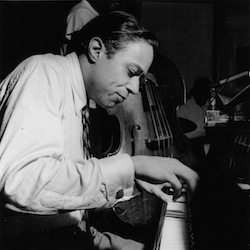
Horace Silver
It was the best of times back then when a young, gifted Horace Silver and the mysterious, enigmatic, tragically doomed jazz genius Gigi Gryce walked the streets of Hartford—giants in our midst—and were playing and making history in jazz clubs in the Capital City. In one of the most dramatic events in all of Hartford’s jazz history, Silver, a Norwalk native and future jazz immortal, was discovered one night by the famous tenor saxophonist Stan Getz who just happened to show up after a gig at the State Theater, sweeping into the Club Sundown where he was bowled over by Silver’s hard-swinging piano solos and rhythmic comping that rocked the house.
Much as it is today, Hartford, even back then long before jazz became fervently embraced by academia, was a fertile breeding ground of promising young talent. Gifted musicians back then taught themselves how to improvise by listening to recordings of the masters and by playing at jam sessions where they learned hands-on from their elders, a generational method of learning and teaching as ancient as the medieval craft guilds. There were no classroom lectures, no formal seminars, just visceral life experiences, high-noon showdowns in gloriously loud, cramped, smoke-filled clubs like the vibrant ones in the North End. These were real-life, unforgiving testing grounds where you had better know how to swing and have mastered the chord changes to everything, not just blues changes and “I Got Rhythm” changes.
Jazz was a do-it-yourself art form back then, not yet thought of as morally or aesthetically fit for the college classroom. It was more like a love that dared not speak its name. Or so it was perceived by more prudish tastemakers and rigid gate-keepers of culture and the then grooveless groves of academe.
Today, of course, the classroom has enormous impact in perpetually rejuvenating jazz through widespread education programs that yearly produce fresh armies of highly trained musicians and composers. Right here close to home, the jazz scene has been enormously enriched in recent decades through extraordinary jazz education programs at high schools, like West Hartford’s award-winning Hall High. On the college level, there are such prestigious programs of higher learning in the area as The Hartt School’s Jackie McLean Institute of Jazz at the University of Hartford. In nearby Middletown, there’s Wesleyan University’s acclaimed world and jazz music studies overseen by a formidable brain trust that has included such intellectual and performance luminaries as Bill Barron, Ed Blackwell, Anthony Braxton and Jay Hoggard, among others.
In the post-war era’s jazz boom, Hartford’s Young Lions like Cliff Gunn, Walter Bolden and Harold Holt jammed in local clubs with the city’s best and brightest, as well as with visiting jazz potentates from the Big Apple. Unlike the jazz concerts at The Bushnell, Foot Guard Hall or the State Theater, venues in the remarkably swinging club scene in the North End—at nightspots like Club Sundown and The Subway—coming attractions were promoted mostly by word of mouth. Unless you were completely up to speed with the dynamic North End scene, you might well run into somebody downtown one day and discover that a visiting grandee from the Big Apple like Sonny Stitt had played superbly at one of the clubs just the night before.
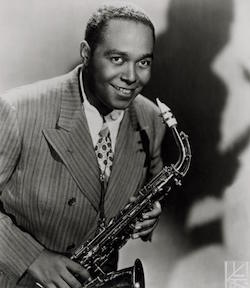
Charlie Parker
Visiting jazz giants like Charlie Parker and Coleman Hawkins were among a host of jazz titans and semi-titans who thought of Hartford as a happy stomping ground. For them it seemed stocked with fine players, skilled rhythm sections, and, conveniently, was a relatively short drive or train ride from New York or Boston.
At the time, bebop was the radical “new thing.” It was revolutionary both musically and as a social force foreshadowing such dramatic changes blowin’ in the wind for America as the Civil Rights, Black Consciousness and Black Arts movements. As it is today with its array of conservatory-trained practitioners, Hartford even back then was hip, no mere provincial outpost suffering from a cultural cringe just because it happens to be located half-way between the mega-metropolises of New York City and Boston.
Back then, young, jazz-addicted, Hartford keyboard neophytes like Emery Austin Smith (one of the city’s last grand patriarchs from that original Golden Age who’s still playing and in his prime today) and Norman Macklin were not only auto-didactic students of swing pianists like Earl Hines and Billy Kyle, but were also diligently honing their chops on the then cutting-edge style of such master beboppers as Bud Powell and Al Haig.
Even Hartford’s burbs were crackling with jazz as the Truman Era faded into the Eisenhower Era. But, in some cases, venues on the outskirts of town favored a more mainstream style, digging classic, pre-bebop swingers like Eddie Condon, Hot Lips Page and the godlike Sidney Bechet, who were among the many more traditional greats jamming in Newington at the Matarese Circle, then one of the area’s many red-hot spots for jazz. Among the Connecticut notables jammng there were the then well-known multi-instrumentalist Dick Cary, a Hartford native, and pianist Jack O’Brien, a Middletown native, who was among the first American jazz musicians to perform throughout Europe in the 1920s.
As part of his movable feast in Paris, O’Brien, a closet jazz intellectual, became acquainted with such modern cultural icons as the American expatriate writer Gertrude Stein and the French composer Maurice Ravel. During the Depression, O’Brien, who was as celebrated for his imagination and outrageous Irish wit as he was for his bold piano playing, worked at the old Club Hollywood in Rocky Hill, a nightspot owned by his boyhood friend, the famous bandleader Tony Pastor.
All that wide-spread jazz activity in Hartford and elsewhere in the state was an accurate barometer of national popular tastes of that period. It was a time when jazz—yes, jazz—had massive public appeal everywhere from concert halls like Carnegie Hall to local gin mills and juke joints. It was on the radio and even on the silver screen.
Jazz back then was the rock ‘n’ roll of its day, complete with superstars like Benny Goodman and Duke Ellington, two bona fide American idols of the period who happily performed in Hartford.
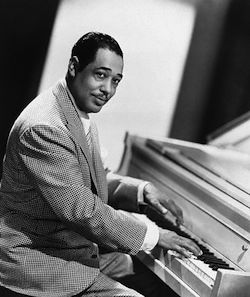
Duke Ellington
Ellington, who began appearing in Hartford in the 1930s, was one of the major pioneering black artists whose music leapt over the hurdles of the period’s steep racist barriers, mesmerizing a crossover audience of blacks and whites with his consummate artistry and aristocratic image. In Terry Teachout’s new, acclaimed biography, “Duke: A Life of Duke Ellington,” he writes that Ellington began writing his masterpiece, the “Black, Brown and Beige” suite, in 1942 backstage at the State Theater where his band was sharing the bill with Frank Sinatra. Early in 1943, the grandiose work, which had begun in humble settings at the State Theater, premiered at Ellington’s debut performance at Carnegie Hall.
Goodman, “the King of Swing,” liked Connecticut so much that he eventually enthroned himself in a regal home in Stamford. The clarinetist/bandleader was a transplant among a number of other jazz greats who settled permanently in Connecticut, including Dave Brubeck in Wilton and Gerry Mulligan in Darien.
As with any historical Golden Age—even one as lustrous as Hartford’s—there’s a tendency to romanticize the period. Especially so when looking back on jazz, an art form that since those long gone halcyon days, has been frequently diagnosed as very close to death, its financial status often hanging by a thin thread.
Jazz’s darkest hour, both in Connecticut and nationwide, was in the early 1960s when rock seemed like the irresistible force that would crush jazz under the sheer weight of its phenomenal commercial success that threatened to suck all the oxygen out of the marketplace.
So when you look back from the perspective of jazz’s too frequent near-death experiences over the past few decades, that Golden Age from long ago seems even more golden, even more lead-free. It was, after all, an era when jazz was jumpin’ in Hartford and around the state, alive and well from the robust, full houses at Foot Guard Hall to the now mythic-seeming big band concerts that consistently drew huge, enthusiastic turnouts at Lake Compounce in Bristol.
But, perhaps, the truth of the matter is that Hartford at this present moment in 2014– despite all the usual jazz ailments, including the Darwinian cycle of the rise and sometimes rapid demise of jazz venues– is enjoying its very own, new Golden Age. Not just 60 or 70 years ago, but right here and now in this present, fleeting moment.
Among the vital signs of today’s new 24-karat Jazz Age is the most obvious fact that the local scene is teeming with talent, locally grown and increasingly nationally renowned. An extremely jazz-friendly Hartford has become noted as a manufacturing center for the creation of fine, domestically-raised products ranging from the dazzling double bassist Dezron Douglas to the remarkable Curtis brothers, pianist Zaccai Curtis and bassist Luques Curtis, local jazz favorites since they were child prodigies dazzling local fans everywhere from Bushnell Park to Real Art Ways.
Talent is evident virtually everywhere within earshot, whether with well-established figures like trombonist Steve Davis, bassist Nat Reeves and saxophonist Rene McLean, noted professor/performers at The Hartt School, to the long honor roll of extraordinary musicians who have emerged just from Hall High School alone. Among the litany of Hall hallmarks are the Grammy-nominated pianist Brad Mehldau, an important stylistic influence on the whole succeeding generation of pianists coming up behind him; plus his classmate and friend, saxophonist, Joel Frahm; drummer Richie Barshay and saxophonists Erica von Kleist, Kris Allen and Noah Preminger, just to name a few examples from a litany of worthies.
Another tangible and delightful sign of the present day Golden Age is the vast array, almost a glut of first-rate concerts and festivals offered in Hartford and throughout the state itself.
In Hartford alone you can sample the Monday Night Jazz Series in Bushnell Park; The Greater Hartford Festival of Jazz, also in the downtown park, and the Baby Grand Jazz Series at the Hartford Public Library. Rather amazingly, all are free of charge. During the year, Hartford’s Artists Collective and Real Art Ways also chime in with first-rate jazz presentations. Thanks to the empathetic ear of its Executive Director Will K. Wilkins, RAW keeps the new music flame alive in Hartford, stoking it with, for example, its acclaimed “Improvisations” series curated by the cutting-edge cornetist/trumpeter Stephen Haynes and bassist/guitarist Joe Morris.
Along with the weekly “Monday Night Jazz” series at Black-eyed Sally’s and impresario/fashion designer Dan Blow’s cornucopia of jazz and cabaret offerings at his boutique, Japanalia Eiko, plus his Sunday jazz brunches at The Wadsworth Atheneum Museum of Art, there are no signs of either the death of or even the dearth of jazz in Hartford. Even if you hate jazz, it would be hard to avoid it in town.
And in yet another sign of robust health, the latest newcomer on the scene in Connecticut is Old Lyme’s superb Side Door Jazz Club, which is presenting a parade of such top-name performers as Fred Hersch and Nicholas Payton with its celebratory fare.
Besides all these big, knockout presentations, jazz is even bobbing- and-weaving its stylish way through a wide variety of seemingly offbeat venues, resounding everywhere from pizza parlors in Bloomfield and Bethel to a French bakery/café in West Hartford Center, to Ed Krech’s free Saturday matinee jam sessions held right in his brick-and-mortar, bin-lined, mom-and-pop jazz record shop in Wethersfield.
Other vital life-signs statewide include the nationally heralded Litchfield Jazz Festival (LJF), a creation of one of the greatest behind-the-scenes forces in Connecticut jazz history, Vita Muir. A one-woman cultural industry, Muir single-handedly created the festival which has become a premier cultural event in Connecticut with its widely varied, jazz cordon bleu fare. Likewise, for trad jazz aficionados there’s the Hot Steamed Jazz Festival in Essex, specializing in red-hot traditional music.
New Haven, another major Connecticut city with a glorious jazz history, celebrates its own jazz heritage with the New Haven Jazz Festival, a free event that draws many thousands to the historic New Haven Green. The festival, which is rooted in deep pride and vital consciousness of the history of jazz in the Elm City, loves to present headliners with New Haven roots. Among these are such extraordinary players as saxophonist Wayne Escoffery. Born in London, Escoffery grew up in New Haven before coming to Hartford to study with his great mentor, Jackie McLean. As in Hartford, there are many fascinating facets to the mosaic that makes up the Elm City’s jazz history.
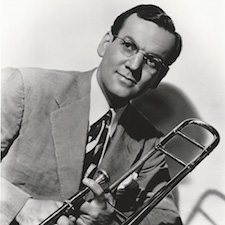
Glenn Miller
In a nationally celebrated news event during World War II, for example, the famous big band leader Glenn Miller, who had enlisted in the Army Air Corps, was headquartered in New Haven for 1 ½ years, marshaling his big band music as a wartime morale and recruitment booster. Miller, who was then a captain, formed and led the 418th Army Air Force Band made up of servicemen who had been musically skilled civilians before the war. Led by the big band maestro in full military regalia, the band of soldier/musicians presented concerts for Yale students and local residents, and marched in patriotic parades in New Haven to a jazzy beat undreamed of by the “American March King,” John Philip Sousa.
Most famously, Miller and his military band broadcast live, weekly radio shows from Yale’s Woolsey Hall, upbeat recruitment programs orchestrated to attract young men to enlist in the Air Corps. While living full-time in New Haven, Miller reportedly stayed at the historic, downtown Taft Hotel. Growing impatient with his stateside duty, the patriotic bandleader volunteered to play for the troops overseas despite the obvious danger. Six months after leaving New Haven, Miller was dead, disappearing mysteriously on a flight from England to Paris where he was scheduled to entertain the troops. His body was never recovered.
Mirroring Hartford’s urban-rooted jazz history in many ways, New Haven also has a non-profit, all-volunteer, jazz advocacy group, called Jazz Haven. Jazz Haven, with staunch jazz warriors like Doug Morrill often at the forefront, has helped keep jazz alive in New Haven, much as The Hartford Jazz Society has done in Hartford for more than a half century.
New Haven’s illustrious jazz history also boasts Yale’s prestigious Duke Ellington Fellowship Program, created and run by Professor Willie Ruff, the noted French horn player, double bassist, jazz savant, historian, memoirist and partner with pianist Dwike Mitchell in the celebrated Mitchell/Ruff Duo. The distinguished program has paid homage to creative luminaries ranging from such towering cultural figures as Marian Anderson and Paul Robeson to such jazz giants as Dizzy Gillespie and Dave Brubeck. (In another Elm City historical note, superstar clarinetist/bandleader Artie Shaw was raised in New Haven. Among musicians born in the Elm City were bandleader/trombonist Buddy Morrow and the excellent, if sadly underrated pianist/accordionist Pete Jolly).
Yet another centerpiece of New Haven’s vital jazz legacy is Firehouse 12, a nationally celebrated bastion for the performance and the recording of cutting-edge music. Firehouse 12 is an invaluable haven for new music, just as the relative newcomer to the Connecticut jazz scene, Jeff & Joels’ Houseparty in Guilford, is a great, foot-stomping, partying refuge for good, old-time sounds like ragtime, New Orleans, boogie-woogie, swing, stride and blues.
While today’s active jazz scene marks one of Hartford’s brightest hours, the early 1960s were, in many ways, among its darkest, even though there have always been some inspiring points of light. Through those Dark Ages, its saviors leading the way to enlightenment have long included such old standby, life-saving forces as The Hartford Jazz Society,
Ironically, however, it was the death of the beloved Heublein—a victim of Hartford’s unbridled passion in the early ‘60s for the bulldozer and wrecking ball of urban renewal—that led to the birth of the HJS, one of the most pivotal events in the city’s jazz history.
Art Fine, another one of the central, behind-the-scenes forces on behalf of jazz, and his circle of jazz-loving friends frequented the Heublein in the 1950s, a congenial spa to have a drink and hear jazz greats like Dave McKenna, Roy Eldridge, Teddy Wilson, Zoot Sims or Cannonball Addelerley. (The Heublein’s dream team fare was booked by Paul Landerman (1916-2008), one of Connecticut’s most famous society bandleaders, jazz impresarios, booking agents and concert presenters.) Fine’s kindred jazz spirits, including Malcolm-Smith, met often after work over drinks and the top-shelf jazz served at the Heublein. All were appalled, even horrified by the impending doom of the Heublein, which they viewed as a historically catastrophic blow for jazz in Hartford. Something had to be done. Plans had to be made. Fine’s hilltop home in Bloomfield became the new meeting place for the jazz devout where they could thrash out their ideas about saving jazz, which they believed was being uprooted by the destruction of the iconic Heublein.
Fine’s spacious home, the new suburban salon for the Heublein refugees, eventually became the jazz-friendly site for great, Gatsby-like parties where there was no shortage of camaraderie, food and drink, But first came the seminal planning sessions for what to do about the imperiled state of jazz in Hartford. As the HJS was launched, Fine’s living room, which was graced with a beautiful and well-tuned piano, was often alive with the sound of music, including that of the great pianist Randy Weston, one of Fine’s many close jazz friends who also became a lifetime pal with the HJS.
As part of Fine’s new, live and glorious, in-house soundtrack—especially at his fabled birthday parties and pre-concert and post-concert festivities—there were the brassy notes of trumpeter Roy Eldridge one night, the hard, gritty tenor sounds of the great Booker Ervin some other night. Or it could be generated by other special guests like the great Willie “The Lion” Smith rollicking away on the piano for Fine and his house full of partying jazz lovers. “Oh, God it was wild!” recalls Lucy Marsters, a former HJS president and longtime friend of Fine. “Art’s parties were the greatest! His home was open. I went into Art’s kitchen one night, and the next thing I knew I was having a drink with Kenny Burrell, the great jazz guitarist!” Marsters says, her voice still full of wonder even all these decades later.
That homey ambience at Fine’s fests and the collegial sense of bonding together for a worthy cause was, in some ways, a foreshadowing of Dr. Steven Sussman’s annual “Jazz for Juvenile Diabetes,” star-studded benefit concerts that started out in the Hartford physician’s living room. The far-sighted idea of creating the Hartford Jazz Society was conceived, appropriately enough, on a hilltop with a splendid view and wide horizon. Fine and his fellow jazz visionaries would gather casually on the lawn in front of his home, mapping out their strategic plans for saving jazz in Hartford. Out of these convivial conventions of the founders on the lawn was created a non-profit organization whose army of unpaid volunteers, over the decades, has helped keep jazz afloat even while the HJS itself has had to weather some hard, financially life-threatening times of its own. No one ever said jazz was easy.
Fine, a pragmatic, highly successful businessman with high philosophical ideals, took pride in the HJS’s great musical accomplishments, but also felt, as a founding father and the HJS’s first president, that the socially idealistic, culturally liberal group was way ahead of its time on such vital social and historical issues as race in America.
“I think that the Jazz Society’s most important accomplishment wasn’t just the music, so much as the fact that it was one of the first totally integrated social organizations in the area. Blacks and whites socialized naturally, with no strain, no pretensions,” Fine told The Courant in 1985 when the HJS was celebrating its silver anniversary. “The Jazz Society provided a framework for amicable integration, and in that sense it was way ahead of its time. Back then when we were just getting started in 1960, the musicians’ union was still segregated. There was a white union for white musicians and a black union for black musicians—a sociological and historical fact that gives you an indication of the tenor of the times,” he said.
Fine died in late 2007 at 96, but his legacy lives on through the HJS, a remarkable accomplishment for a man who never played a note in his life. Jazz has had a number of saviors over the last half-century or so besides rugged individualists and idealists like Fine and dedicated groups like the HJS, who have often provided life-support for jazz.
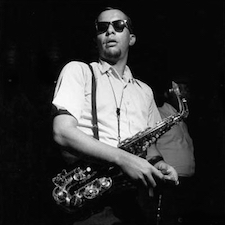
Jackie McLean
Among these miracle workers are such jazz heroes as Jackie McLean and his wife, Dollie, and bassist Paul Brown, the much revered Big Daddy of the ongoing concept of free, outdoor jazz festivals in Hartford. Besides founding the Artists Collective and what is now called The Jackie McLean Institute of Jazz at U of H, Jackie McLean, a Harlem native, brought big name recognition and cultural cachet to Hartford when he settled here with his family and began teaching at the University of Hartford, becoming a nationally respected, innovative jazz educator. Graduates of McLean’s influential program are performing and recording throughout the jazz world, constituting a living, ever expanding legacy for the NEA Jazz Master who died at 74 in 2006.
Brown, another Hartford jazz saint, in the early 1960s began the still-running Monday Night Jazz Series, one of the most lasting achievements in the city’s jazz history.
As a concert-producer, Brown, a globe-trotting professional bassist, brought an amazing array of talent to town, including Thelonious Monk, Bill Evans and the Modern Jazz Quartet. All this was accomplished despite his having to work on a shoestring budget. In later years, Brown somehow kept the popular series going despite its facing virtual extinction from season-to-season because of chronic, life-threatening shortfalls in funding.
From the Monday Night Jazz series, which is now presented by the HJS, was spun off The Greater Hartford Festival of Jazz (GHFJ), which was initially created as an homage to Brown, Hartford’s master builder of jazz festivals. A free outdoor bash in Bushnell Park, the GHFJ serves a menu rooted in contemporary jazz. Like its older sibling, the Monday Night Jazz series, the GHFJ every summer fills the downtown park with thousands of fans.
The history of jazz in Hartford not only has a great narrative line, but is also packed with a colorful cast of leading, dedicated characters, in addition to such prime movers as Fine, the McLeans and Brown. Among these is John Chapin, a onetime Hartford cop who a couple decades ago ran two of the finest, most upscale jazz clubs in Hartford history, Lloyds and Shenanigans.
A well-liked, affable and charismatic club owner, Chapin took enormous pride in presenting high-quality music in a cosmopolitan ambience. His signature mix of chic and substance attracted the smart set from Hartford as well as from the surrounding suburbs, audiences with New Yorker magazine-like demographics in terms of education and earning power. During his remarkable but tantalizingly too short run, Chapin provided one of the city’s richest, most invaluable direct pipelines to top talent from New York and Boston, bringing to town both well-established performers and stars of the future.
Every week, he consistently presented jazz and folk greats, introducing Hartford audiences to such young, then unknown performers as Harry Connick Jr. and Mary Chapin Carpenter. Jazz piano lovers in the 1980s blissfully basked in Chapin’s ongoing stream of such keyboard masters as Hank Jones, Tommy Flanagan, Barry Harris, McCoy Tyner, Dick Wellstood, Dave McKenna and, very near the end of his career, Teddy Wilson.
Chapin served Big Apple sophistication in Hartford and at Hartford prices. Even after all these years, his two outstanding clubs still set the highest benchmark standards for quality venues in Hartford.
Another key pillar of jazz in Hartford was Al Casasanta whose precious legacy for the music was his now legendary 880 Club, one of the greatest, most nourishing hothouses for jazz the city has ever seen. A lovable diamond-in-the-rough, Casasanta was a good-hearted, down-to-earth figure who transformed his South End neighborhood bar into the 880 Club, an unpretentious nightspot that took its name from its address at 880 Maple Ave.
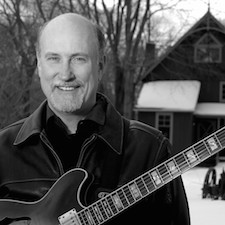
John Scofield
By day, the 880 was a blue-collar neighborhood bar, a kind of Cheers where everybody knows your name. By night, it magically transformed into a classic, packed, noisy, smoke-filled, extremely friendly, relaxed jazz club. It was a cozy nook where you might hear anybody from Al Cohn or Junior Cook to Tom Harrell or John Scofield, backed by the house rhythm section that featured pianist and music director Don DePalma, Mike Duquette on drums and Nat Reeves on bass. It was the place where many young promising musicians, like alto saxophonist Sue Terry and flutist Ali Ryerson, gained invaluable experience jamming in a challenging, live setting with such seasoned, 880 regulars as DePalma, the colorful vibraphonist Matt Emirzian and the inventive drummer Larry DiNatale. Casasanta, who died at 63 in 1995, was loved by musicians who worked for him (a most rare experience for a club owner), as well as by his patrons who idolized his cramped, gritty club much the way devout Red Sox fans are forever devoted to Fenway Park.
There was so much love for Al, in fact, that the genial, charismatic Italian-American became known affectionately and with the deepest respect as the Godfather of Jazz. It was a title he prized, and an accurate reflection of his deeply principled, heart-felt loyalty to the music, the musicians and his patrons.
Through the best of times and the worst of times financially, Casasanta stuck tenaciously and courageously with jazz for years even though good friends and advisers constantly implored him to dump jazz—rarely ever much of a money-maker—and go after easy money by turning the 880 into a topless bar.
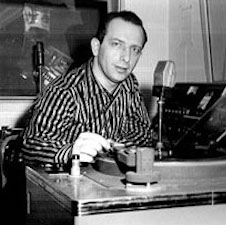
Mort Fega
Casasanta, who wanted no part of that deal, explained to The Courant: “When I die they can put a G clef on my coffin instead of a dollar sign.” Another fascinating central character in Hartford’s historical narrative is Mort Fega (1921-2005), a well-known jazz radio veteran from the New York scene, a classy record company owner and producer who had many influential friends, including Miles Davis, and connections with seemingly everybody in the performing and recording side of the music business.
Fega, who spoke his razor-sharp mind candidly and caustically, caused a much needed stir in a too complacent jazz community after arriving here in the 1970s. Lifting the level of discourse to new, challenging heights with his mellow-toned radio voice and his sometimes combative signature style of intellectual and street-smart hipness, he evangelized, always passionately and often provocatively, for modern jazz, both on the air and with his many blue-chip concert presentations.
Without compromise, fear or favor, Fega always conducted his business with a sense of high style and perfectionist fervor. An Air Force combat veteran of World War II who had flown bombing missions over Germany and Nazi-occupied France, he spoke fearlessly and with invigorating, edgy candor. No one, he asserted, could ever give him worse flak than he got from the Nazis. His direct, unaffected manner deeply irritated some, profoundly inspired others, while perpetually ruffling a lot of feathers that sorely needed ruffling.
Characterizing himself as “a jackleg preacher for jazz,” Fega was a catalytic force for revitalizing change, particularly during the height of his influence in the late ‘70s and early ‘80s. As a promoter, proselytizer and guru, he was sagacious, pugnacious and sardonic—sometimes all three simultaneously. Most significantly, he did much good for jazz in Hartford before moving in the 1980s with his wife, Muriel, to Delray Beach, Fla., where he continued to pursue his sacred calling as a jackleg preacher for jazz.
Hartford has risen to its respectable status in the jazz world today not just through the efforts of all the well-known, influential advocates who have shaped the music’s history over the decades, but also thanks to many figures toiling away every day in the jazz trenches.
These include countless devoted teachers, musicians, fans, supporters in all walks of life, organizations and even the many venues that have come and gone over the decades. These sometimes relatively unsung but no less important contributors to the music’s history range over a diverse legion of dedicated jazz crusaders from early heavyweight champions of jazz like the Hartford Jazz Society’s Sam Johnson and such present day HJS advocates as Bill Sullivan to trumpeter/bandleader/educator Ray Gonzalez, Hartford’s dynamo sparkplug for Latin jazz, and vocalist Nicki Mathis, who uses her art and organizational skills in her long-running war against sexism and racism.
Among these jazz legionnaires are such warriors as: Kevin McCabe, a concert presenter and irrepressible Defender of the Faith in contemporary jazz; the jazz-inspired, expressionist painter/concert presenter Andres Chaparro; photographer/radio host Maurice Robertson; bassist Paul Fuller, an evidently inexhaustible, multi-tasking champion for jazz; the late Ed Strong, a joyfully charismatic HJS president, a life-force and irresistible master recruiter of jazz converts; the photographer/actor Harry Lichtenbaum, former HJS president and dedicated archivist of historic materials related to Hartford jazz and his idol Frank Sinatra; and Paul Lewis, a club owner who held out gallantly for many years at West Hartford’s sadly departed Szechuan Tokyo Restaurant. Despite his years of loving, herculean efforts on behalf of jazz, Lewis’s lease for his jazz-friendly restaurant was ended and his magnificent venture sank. It was a titanic loss still felt by regional patrons and musicians alike.
While jazz in Hartford has had its share of secular saints and martyrs, like Fine, the McLeans, Brown, Casasanta and Lewis, it has also been blessed with a direct line of sorts to a higher power thanks to the invaluable, jazz-friendly support from the city’s historic Asylum Hill Congregational Church (AHCC). Its splendid sanctuary has often afforded a welcoming haven for many great, even historic jazz concerts. Jazz should, in fact, give thanks to AHCC for the devoted support years back from the church’s trumpet playing, Rev. Gary Miller, a now retired senior minister, and, in recent years, for the many pro-jazz stands affirmed by the bold deeds of Steven Mitchell, minister of music and arts.
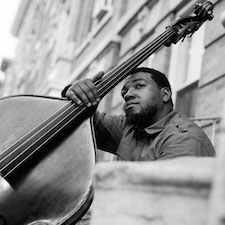
Dezron Douglas
All of these historic figures and other shakers-and-doers and many complex economic, social and cultural forces, have somehow transformed a medium-sized city like Hartford into a wonderfully and disproportionately significant factor in the wide world of jazz in 2014. Word of Hartford’s proud jazz history has been spread nationally and internationally by the constantly growing number of high-quality musicians who have been schooled and shaped by the capital city’s vibrant jazz scene, and then gone out on their own and made their mark in the jazz world itself. Dezron Douglas, who was born and raised here, reports that the buzz on the New York club scene today is that there is now “the Hartford sound,” a style so individual that it has a name and a historic, geographical and stylistic category all its own.
Few cities—even those many times larger than Hartford—can point to such a proud jazz history that has produced a distinctive sound uniquely its own. That’s a ringing endorsement any city might well savor among its prized cultural accomplishments. It even has the resonant sounding glow of a new Golden Age of Jazz for Hartford, one that’s happening right now and has no expiration date.



